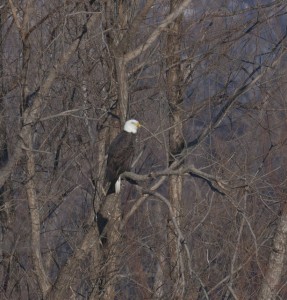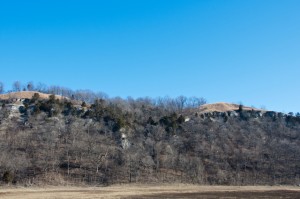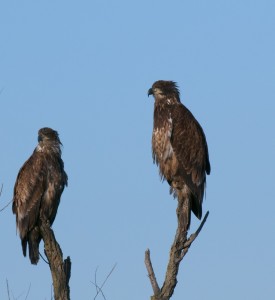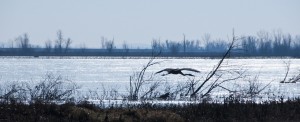Conservation Works
This American Bald Eagle epitomizes the interconnected landscape of our bluff lands. The eagle spent the night roosting in a tree up in the bluffs. Later in the day, when the air warmed enough to make possible energy-saving thermals on which to soar, the eagle moved to the bottomlands in search of a meal.
The rich bottomlands provide good foraging grounds for eagles, tall trees in the bluffs provide nighttime roosts for shelter and early morning sunshine allowing eagles, and all else to soar and thrive.
The interconnected landscape makes possible new generations of American Bald Eagles, like these youngsters shown here.
We, too, are connected to the landscape, perhaps more strongly than ever before in human history. We shape and form the land, outline and set boundaries — both real and physical as well as metaphorical and intangible — between what we think of as “natural lands” and “human-use lands.”
Far from being watertight, the boundaries between “natural” and “human-use” lands are porous.
Invasive plants offer a good example: 30 years ago, bush honeysuckle rarely appeared in our bluff lands. The Asian shrub was recommended to homeowners as a pretty ornamental that would provide food for wintering birds. Today, bush honeysuckle has spread far and wide from its original planting areas in urban and suburban gardens and now is one of the greatest threats to natural areas, as this exotic, invasive plant pest crowds out native vegetation along with the humans who want to simply walk through the woods but now find that they cannot penetrate even the edges of their properties due to the thick, rank growth of bush honeysuckle plants.
But, conservation works. Each of us has a part to play and a task to take up, beginning with the realization that the way we regard “natural” and “my space” involves little, if any, real distinction. Your garden, your personal landscape, can be a mini-nature preserve; your stewardship of your land, your care and participation in stewardship of public and private lands, can benefit everything we (still) catagorize as “natural.”
We’ve designed this section to bring you more information on the workings of conservation: gardening with natives; agency assistance; contractors for more labor-intensive stewardship work, and an entire section on invasive plants and control methods. Planning is an important part of working conservation, so, we’ve also included our planning documentation: the Southwestern Illinois Wildlife Action Plan (SWIWAP) and the SWIWAP Partnership annual reports, and a link to the overall state planning document, the Illinois Wildlife Action Plan (IWAP).
We encourage planning, and patience for working your very own conservation projects, because we know this work takes time, takes labor, may cost some money, but the rewards can be as beautiful as the delighted smile of yourself — or your child or grandchild — seeing an adult American Bald Eagle soaring over our bluff lands.




